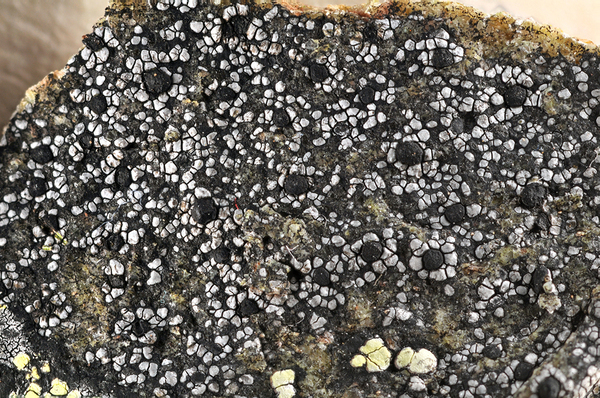Rhizocarpon simillimum (Anzi) Lettau
Hedwigia, 52: 156, 1912. Basionym: Buellia simillima Anzi - Comm. Soc. Critt. Ital., 2, 1: 19, 1864.
Synonyms: Buellia subbadia Anzi; Catocarpus simillimus (Anzi) Arnold; Rhizocarpon atroalbum var. africanum Flagey; Rhizocarpon sublestum (Nyl.) Zahlbr.
Distribution: N - Frl (TSB 4365), TAA (Nascimbene & al. 2022), Lomb, Piem (Giordani & al. 2014), VA (Piervittori & Isocrono 1999, Valcuvia 2000, Matteucci & al. 2015c), Emil (Fariselli & al. 2020). C - Tosc, Sar (Nöske 2000). S - Camp (Garofalo & al. 1999), Cal (Puntillo 1996).
Description: Thallus crustose, episubstratic, grey-brown to dark brown, rimose-areolate, delimited by a black prothallus, forming patches up to 5 cm in diam. Areoles contiguous or scattered, rounded to angular, mostly flat, up to 0.3 mm in diam. Medulla white, I+ blue. Apothecia round to angular, up to 0.8 mm across, with a more or less flat, epruinose disc, and a thin, usually persistent, sometimes finally excluded proper margin. Proper exciple brownish black, K+ reddish violet; epithecium brown to brown-black, without crystals, K- or K+ faintly reddish violet; hymenium colourless; hypothecium dark brown, K+ reddish violet. Asci 8-spored, clavate, fissitunicate, with a well-developed tholus, lacking an ocular chamber, Rhizocarpon-type. Ascospores 1-septate, soon dark brown-black, ellipsoid, 10-16 x 5-8 µm. Photobiont chlorococcoid. Spot tests: medulla K- or K+ pale yellow, C-, KC-, P-. Chemistry: without lichen substances, or with variable amounts of stictic acid.Note: on steeply inclined surfaces of siliceous, base-rich or slightly calciferous rocks in upland areas; present both in the Alps and along the Apennines, south to the mountains of Calabria.
Growth form: Crustose
Substrata: rocks
Photobiont: green algae other than Trentepohlia
Reproductive strategy: mainly sexual
Commonnes-rarity: (info)
Alpine belt: rare
Subalpine belt: rather common
Oromediterranean belt: very rare
Montane belt: rare
Submediterranean belt: absent
Padanian area: absent
Humid submediterranean belt: absent
Humid mediterranean belt: absent
Dry mediterranean belt: absent

Predictive model
Herbarium samples
Growth form: Crustose
Substrata: rocks
Photobiont: green algae other than Trentepohlia
Reproductive strategy: mainly sexual
Commonnes-rarity: (info)
Alpine belt: rare
Subalpine belt: rather common
Oromediterranean belt: very rare
Montane belt: rare
Submediterranean belt: absent
Padanian area: absent
Humid submediterranean belt: absent
Humid mediterranean belt: absent
Dry mediterranean belt: absent

Predictive model
| Herbarium samples |
 Index Fungorum
Index Fungorum
 GBIF
GBIF


